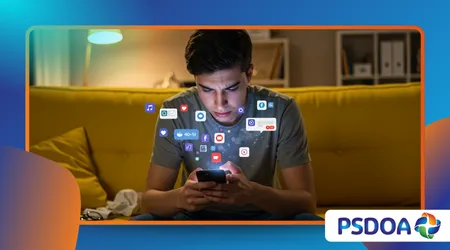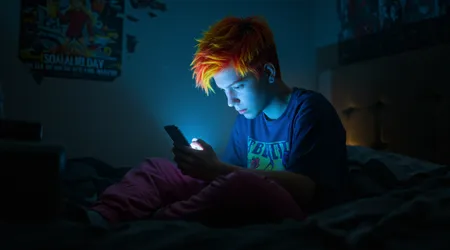Dopamina digital: cómo las aplicaciones secuestran el sistema de recompensas

Dopamina digital recorre nuestro cerebro cada vez que deslizamos el dedo, tocamos o nos desplazamos, encendiendo una chispa de anticipación que nos mantiene atados a nuestras pantallas.
Anuncios
En 2025, las aplicaciones habrán dominado el arte de explotar nuestro cableado neurológico, convirtiendo las interacciones casuales en hábitos compulsivos.
No se trata sólo de tecnología, sino del comportamiento humano, la psicología y las formas sutiles en que se manipulan nuestros sistemas de recompensa.
¿Por qué sentimos la necesidad de revisar nuestros teléfonos constantemente? Este artículo profundiza en la ciencia de... Dopamina digital, explorando cómo las aplicaciones generan adicción, el costo psicológico que conlleva y las estrategias para recuperar el control.
Desde las redes sociales hasta los juegos, descubriremos la mecánica detrás de este fenómeno moderno, basado en investigaciones reales y conocimientos prácticos.
Anuncios
El encanto de Dopamina digital radica en su capacidad de imitar las recompensas naturales, como la comida o la conexión social, pero con una intensidad amplificada.
Nuestros cerebros, desarrollados para la supervivencia, buscan la dopamina, un neurotransmisor vinculado al placer y la motivación. Las aplicaciones aprovechan esto ofreciendo recompensas impredecibles que nos mantienen enganchados.
Un estudio de 2021 en Comunicaciones de la naturaleza Descubrieron que los usuarios de las redes sociales espacian las publicaciones para maximizar los “Me gusta”, lo que refleja el comportamiento de búsqueda de recompensas en una caja de Skinner.
Esto no es casualidad, sino una idea. Los desarrolladores utilizan la psicología conductual para crear experiencias irresistibles, convirtiendo momentos fugaces en horas de interacción.
Pero no se trata solo de "me gusta" o notificaciones. Hay mucho más en juego: nuestra salud mental, nuestra capacidad de atención y nuestras relaciones están en riesgo.
A medida que las aplicaciones se vuelven más sofisticadas, comprender su influencia en nuestra psique es crucial. Esta exploración revelará cómo Dopamina digital moldea nuestros hábitos, por qué es tan difícil liberarnos y qué podemos hacer al respecto.
Profundicemos en los mecanismos, impactos y soluciones, con ejemplos del mundo real y pasos prácticos para navegar por este laberinto digital.
La ciencia detrás de la dopamina digital
Nuestros cerebros anhelan la dopamina, la sustancia química que indica la recompensa, lo que nos impulsa a repetir comportamientos que nos hacen sentir bien. Las aplicaciones se aprovechan de esto al ofrecer... Dopamina digital en ráfagas.
Las plataformas de redes sociales, como TikTok, utilizan programas de recompensas variables (me gusta o comentarios aleatorios) para mantener a los usuarios anticipando el próximo éxito.
Esto refleja lo que ocurre en las máquinas tragamonedas, donde la incertidumbre alimenta la compulsión. El área tegmental ventral, un centro clave de dopamina, se activa con cada notificación, reforzando el ciclo del hábito.
Esto no es solo teoría; es medible. Estudios de neuroimagen muestran que las redes sociales desencadenan las mismas vías de recompensa que la comida o las drogas.
La imprevisibilidad de la retroalimentación, como un retuit sorpresa, aumenta la dopamina más que las recompensas predecibles.
++ Doomscrolling: Por qué no podemos dejar de consumir malas noticias
Las aplicaciones se aprovechan de esto creando feeds interminables, lo que garantiza que nunca sepamos qué sigue. Esta anticipación constante reconfigura nuestro cerebro, haciendo que la desconexión se sienta como privación.
¿El resultado? Un ciclo de búsqueda y recompensa difícil de romper. Plataformas como Instagram usan algoritmos para retener los "me gusta" y entregarlos posteriormente en ráfagas para maximizar el impacto.
Este diseño deliberado nos mantiene navegando, buscando la siguiente dosis de dopamina. No se trata solo de placer, sino de ansia, un cambio sutil pero poderoso en nuestro cableado neuronal.

Cómo las aplicaciones generan adicción
Los desarrolladores de aplicaciones no se topan con diseños adictivos; los crean con precisión. Al aprovechar Dopamina digitalLas aplicaciones crean bucles de retroalimentación que parecen naturales pero que no lo son en absoluto.
Por ejemplo, en aplicaciones de juegos como Candy Crush, cada nivel que completas desencadena una descarga de dopamina, lo que motiva a los jugadores a seguir jugando. Las notificaciones push actúan como señales, atrayendo a los usuarios con promesas de recompensas, como un nuevo mensaje o una oferta por tiempo limitado.
Los algoritmos analizan el comportamiento del usuario para personalizar el contenido y aumentar la interacción. Por ejemplo, el motor de recomendaciones de Netflix sugiere programas según visualizaciones anteriores, lo que mantiene a los espectadores enganchados.
Esto no es aleatorio, sino que se basa en datos y está diseñado para maximizar el tiempo invertido. Un estudio de 2022 señaló que el algoritmo de TikTok crea una "experiencia fluida", que combina el disfrute con la distorsión del tiempo, haciendo que las horas se desvanezcan.
Lea también: La psicología detrás del “no contacto” en las relaciones
Ejemplo del mundo real: Sarah, una profesora de 28 años, revisa Instagram por reflejo durante los descansos, atraída por las notificaciones que prometen “me gusta”.
El algoritmo de la aplicación le proporciona contenido seleccionado, manteniéndola enganchada más tiempo del previsto. Esto no es un defecto, es el objetivo. Los desarrolladores utilizan pruebas A/B para perfeccionar las funciones, garantizando que cada deslizamiento proporcione la información necesaria. Dopamina digital Para que los usuarios regresen.
El costo psicológico de la dopamina digital
Exposición constante a Dopamina digital No es benigno, sino que transforma nuestro panorama mental. El uso excesivo de aplicaciones altera la atención, y estudios lo vinculan con una menor concentración y productividad.
La corteza prefrontal, responsable de la toma de decisiones, se debilita bajo estimulación constante, lo que dificulta el autocontrol. Los adolescentes, con cerebros en desarrollo, son especialmente vulnerables y presentan mayor ansiedad por el uso excesivo de las redes sociales.
La comparación social agrava el problema. Plataformas como Instagram amplifican la sensación de incompetencia cuando los usuarios se comparan con vidas seleccionadas.
Esto provoca una bajada de dopamina, impulsando a los usuarios a buscar mayor validación mediante publicaciones o desplazamientos. Con el tiempo, esto puede conducir a una desensibilización a la dopamina, donde las recompensas naturales, como una puesta de sol, pierden su atractivo en comparación con las experiencias digitales.
Leer más: Por qué al cerebro le encantan las teorías de la conspiración
Imaginemos a Jake, un joven de 17 años que pasa horas en TikTok buscando "me gusta" para sentirse valorado. Cuando los "me gusta" disminuyen, se siente ansioso y navega más para recuperar la euforia.
Este ciclo refleja la adicción, con Dopamina digital Conducta compulsiva al volante. Un estudio de 2025 muestra que el 651% de los adolescentes reportan ansiedad relacionada con las redes sociales, lo que destaca el costo emocional de estas plataformas.
El sistema de recompensa del cerebro se adapta a la estimulación constante, exigiendo más para sentirse satisfecho. Esto puede provocar anhedonia, donde los placeres cotidianos pierden sentido.
El costo no es sólo personal, sino que también afecta las relaciones, ya que los usuarios priorizan las pantallas sobre las conexiones reales, creando un ciclo de retroalimentación de aislamiento y ansia.
El papel de la IA y los algoritmos
La inteligencia artificial se potencia Dopamina digital Al adaptar las experiencias a cada usuario, los algoritmos rastrean los clics, el tiempo de permanencia y las preferencias para ofrecer contenido altamente relevante.
El algoritmo de YouTube, por ejemplo, sugiere vídeos que coinciden con visualizaciones anteriores, lo que mantiene a los usuarios enganchados. Esta personalización crea una sensación de inevitabilidad, como si la app te conociera mejor que tú mismo.
El aprendizaje automático perfecciona estos sistemas en tiempo real. Cuando te quedas en una publicación, el algoritmo la registra y prioriza el contenido similar.
Esto crea un ciclo de retroalimentación impulsado por la dopamina, donde cada interacción se siente excepcionalmente gratificante. Un informe de 2025 de Fronteras Se descubrió que el algoritmo de TikTok fomenta la adicción al optimizar el “flujo”, difuminando el tiempo y la realidad.
Pero la IA no es solo reactiva, sino también predictiva. Anticipa qué te mantendrá enganchado, como una máquina tragamonedas que conoce tu apuesta favorita.
Esto plantea cuestiones éticas: ¿son los usuarios libres o son marionetas del código? La integración fluida de la IA dificulta la resistencia, ya que cada deslizamiento parece una elección, pero está muy guiado.
Consideremos a María, que abre X para ver una publicación, pero se queda una hora, atraída por el contenido personalizado. La precisión del algoritmo la hace sentir vista, pero está manipulando su atención.
Esto no es un error, es una característica diseñada para maximizar la participación a través de un esfuerzo incansable. Dopamina digital entrega.
Estrategias para romper el ciclo
Liberándose de Dopamina digital Requiere esfuerzo, pero es posible. Empieza con aplicaciones de seguimiento del tiempo, como el Panel de Bienestar Digital de Google, para supervisar el uso.
Establece límites diarios en el uso de redes sociales para reducir el uso compulsivo. Reemplaza el tiempo frente a la pantalla con actividades fuera de línea, como leer o hacer senderismo, para recalibrar las vías de recompensa.
Las notificaciones conscientes pueden ayudar. Desactiva las alertas innecesarias para reducir los desencadenantes de dopamina. Por ejemplo, desactivar las notificaciones push de Instagram reduce la necesidad de revisarlas por reflejo.
Otra táctica: pon la pantalla del teléfono en escala de grises. Esto reduce el atractivo visual y hace que las aplicaciones sean menos atractivas, ya que las señales de color provocan picos de dopamina.
La fricción deliberada, como los bloqueadores de aplicaciones, impide el uso descuidado. Herramientas como Freedom bloquean las aplicaciones que distraen durante un horario determinado, lo que obliga a tomar decisiones conscientes.
Un estudio de 2023 de ResearchGate Se descubrió que los paneles de control de tiempo reducen el uso compulsivo en un 30%. Pequeños cambios, como dejar el teléfono en otra habitación, pueden interrumpir el ciclo.
Por ejemplo, Tom, un marketero de 35 años, usa una app para limitar el tiempo de pantalla a 30 minutos diarios. Sustituye el desplazamiento por escribir un diario, ya que lo encuentra más gratificante.
Otro enfoque: programar días de “desintoxicación de dopamina”, evitando las pantallas por completo para restablecer el sistema de recompensa del cerebro.
En definitiva, la conciencia es clave. Reconoce cuándo las aplicaciones manipulan tu comportamiento y recupera tu autonomía. Pregúntate: ¿estás usando la aplicación o ella te está usando a ti?
Al establecer límites y priorizar las recompensas del mundo real, puedes debilitar el control de Dopamina digital y restablecer el equilibrio.
El futuro de la dopamina digital en 2025

A medida que la tecnología evoluciona, también lo hace el poder de Dopamina digitalEn 2025, las plataformas inmersivas como el metaverso amplifican los riesgos de adicción, combinando recompensas virtuales con emociones del mundo real.
Las aplicaciones de realidad aumentada, como los filtros de Snapchat, crean experiencias hiperactivas que impulsan picos de dopamina mediante interacciones gamificadas. La línea entre lo digital y lo real se difumina, intensificando la compulsión.
Están surgiendo regulaciones para frenar los diseños manipulativos. La Ley de Servicios Digitales de la UE exige ahora transparencia en los algoritmos, con el objetivo de reducir las funciones adictivas.
Sin embargo, las empresas tecnológicas innovan más rápido que las leyes, creando nuevas trampas de dopamina. Los dispositivos portátiles, como las gafas inteligentes, integran aplicaciones en la vida cotidiana, lo que dificulta la desconexión.
Imagina a Alex, que usa gafas de realidad aumentada para navegar en redes sociales en tiempo real. La integración fluida se siente natural, pero es como un motor de dopamina que genera recompensas constantemente.
Mientras tanto, crece la defensa de las aplicaciones de diseño ético que priorizan el bienestar sobre la interacción. El futuro depende de equilibrar la innovación con el desarrollo humano.
Esta tabla resume los impactos clave de Dopamina digital y estrategias de mitigación, basadas en la investigación actual:
| Impacto | Descripción | Estrategia de mitigación |
|---|---|---|
| capacidad de atención reducida | Fragmento de notificaciones constantes | Desactivar alertas no esenciales |
| Desensibilización a la dopamina | Las recompensas naturales pierden atractivo | Programe días de desintoxicación de dopamina |
| Ansiedad por comparación social | Las publicaciones seleccionadas provocan inadecuación | Limite el uso de las redes sociales a 30 minutos diarios |
| Comportamiento de comprobación compulsiva | Las aplicaciones explotan los programas de recompensas variables | Utilice el modo de escala de grises o bloqueadores de aplicaciones |
Conclusión
La atracción de Dopamina digital No es casualidad que se trate de un diseño calculado para mantenernos enganchados, explotando el sistema de recompensa de nuestro cerebro con precisión quirúrgica.
Desde los feeds infinitos de las redes sociales hasta las emociones de los juegos, las aplicaciones están diseñadas para cautivar, a menudo a costa de nuestra claridad mental y bienestar emocional.
El panorama digital de 2025, con personalización impulsada por IA y tecnología inmersiva, solo refuerza este control, haciendo que la concientización y la acción sean más urgentes que nunca.
Al comprender cómo Dopamina digital funciona, podemos detectar las trampas, ya sea un ping de notificación o un carrete de video seleccionado, y tomar medidas para recuperar el control.
Piensa en tu cerebro como si fuera un jardín: Dopamina digital Es como la mala hierba que se propaga rápidamente y obstruye el espacio para un crecimiento significativo.
Al establecer límites, como límites de tiempo o filtros de notificaciones, y fomentar las alegrías fuera de línea, podemos cultivar un espacio mental más saludable. El desafío no es solo personal, sino social.
A medida que la tecnología evoluciona, también deben evolucionar nuestras estrategias para mantenernos con los pies en la tierra. Prioricemos las conexiones reales y una vida consciente, asegurándonos de que nuestros cerebros no sean solo peones en el juego de un algoritmo.
¿Qué harás hoy para recuperar tu atención?
Preguntas frecuentes
1. ¿Cómo crean las aplicaciones adicción a la dopamina digital?
Las aplicaciones utilizan programas de recompensa variables, como “me gusta” o notificaciones aleatorias, para desencadenar la liberación de dopamina, lo que fomenta un comportamiento compulsivo similar al juego.
2. ¿Puedo revertir los efectos de la Dopamina Digital?
Sí, al limitar el tiempo frente a la pantalla, usar bloqueadores de aplicaciones y participar en actividades fuera de línea, puedes recalibrar el sistema de recompensa de tu cerebro con el tiempo.
3. ¿Por qué los adolescentes son más vulnerables a la dopamina digital?
Los cerebros en desarrollo de los adolescentes son más sensibles a las recompensas impulsadas por la dopamina, lo que los hace propensos al uso compulsivo de aplicaciones y a los impactos emocionales.
4. ¿Existen aplicaciones éticas que eviten las trampas de la dopamina digital?
Algunas aplicaciones, como las de mindfulness o productividad, priorizan el bienestar por sobre la participación, pero siempre revise su diseño para detectar funciones manipuladoras.
5. ¿Cómo amplifica la IA la dopamina digital?
La IA personaliza el contenido para maximizar la participación, prediciendo las preferencias del usuario para ofrecer dosis de dopamina personalizadas y haciendo que las aplicaciones sean más difíciles de resistir.
